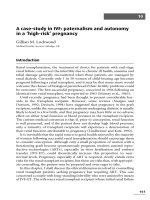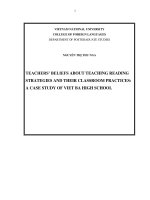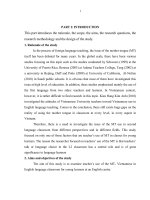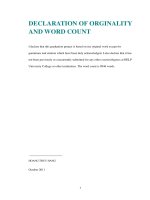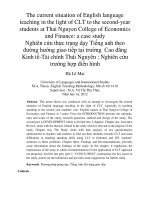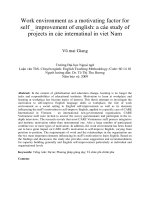Creating happiness in a reading class: A case study
Bạn đang xem bản rút gọn của tài liệu. Xem và tải ngay bản đầy đủ của tài liệu tại đây (297.43 KB, 11 trang )
TRƯỜNG ĐẠI HỌC SƯ PHẠM TP HỒ CHÍ MINH
HO CHI MINH CITY UNIVERSITY OF EDUCATION
TẠP CHÍ KHOA HỌC
JOURNAL OF SCIENCE
KHOA HỌC GIÁO DỤC
EDUCATION SCIENCE
ISSN:
1859-3100 Tập 16, Số 8 (2019): 264-274
Vol. 16, No. 7 (2019): 264-274
Email: ; Website:
Research Article
CREATING HAPPINESS IN A READING CLASS: A CASE STUDY*
Le Thi Tuyet Minh
School of Foreign Languages for Economics
Corresponding author: Le Thi Tuyet Minh – Email:
Received: April 8,2019; Revised: June 6, 2019; Accepted: July 7, 2019
ABSTRACT
Reading, especially for the English majored bachelors, is usually tiring and boring as
they have to study long reading texts and long sessions. This research is a case study in which
the writer attempts to raise students’ learning spirits in reading sessions by carrying out some
physical activities; collective spirit-raising activities; games which include physical
movements, PowerPoint and Kahoot; emotion showing actions; funny stories and riddles. The
paper first presents the research base on learners’ motivation, then analyzes the findings from
the questionnaire asking students’ opinions on the effectiveness of the activities in promoting
students’ spirits. Finally, the writer draws up some suggestions for promoting students’
learning spirits, including turning tasks into games, letting students show their team spirits and
solidarity in class, paying attention to students’ feelings, integrating with drawings and visual arts,
incorporating funny stories and riddles into lessons, breaking lectures into small parts, making
students stand up and move, or do something different, or give them a short break with some quick
relaxing activites. These ideas can also be applied broadly in any other classes, not being
restricted in reading classes.
Keywords: happiness, reading, motivation, promote spirit, students’ engagement.
1.
Introduction
In reading classes, the process of reading and answering the comprehension
questions is rather boring; especially it is tiring for the English majored bachelors who
have to study long reading sessions. So a question is raised: How to promote students’
spirit in reading classes? Abundance of ideas for motivating students have been proposed by
researchers and educators all over the world, and there has also been a lot of research on the
effectiveness of different kinds of games on motivating students, but few studies are in rating
the effectiveness of the spirit-raising activities. In this paper, the writer introduces the
Cite this article as: Le Thi Tuyet Minh (2019). Creating happiness in a reading class: A case study. Ho Chi
Minh City University of Education Journal of Science, 16(8), 264-274.
264
TẠP CHÍ KHOA HỌC Trường ĐHSP TPHCM
Le Thi Tuyet Minh
activities she has applied to enhance students’happinessand engagement. The procedures
include physical exercises, collective spirit-raising activities, games, among which are
facilitated by PowerPoint and web-based platform Kahoot!, and other activities include
emotion showing actions, funny stories and riddles.The students are asked to rate their
favor and the effectiveness of the activities in enhance their spirits. The findingsgive
some suggestions for teachers’ implementation of the teaching process.
2.
Research base
Research has yielded insight into the process as well as the practices for effective
teaching and learning. To engage in learning process, learners must be motivated. To help
understand motivation in instruction we can look at the ARCS Model of Motivational Design
as developed by Keller (1983). The ARCS Model identifies four essential components for
motivation:
[A]ttention: Learners are more motivated when the instructional design generates
curiosity and interest about the content or learning context.
[R]elevance: Learners are more motivated when goals align with their interests.
[C]onfidence: Learners are more motivated when challenge is balanced. The learning
process must not be either too easy as to bore the learner, or too difficult such that
success seems impossible.
[S]atisfaction: Learners are more motivated when there are rewards for correctly
executed actions.
Neuroscience has provided educators and practitioners with practical applications in
language instructions. Helgesen (2018) with the Science of happiness in ELT maintained:
“Positive, motivated students – engaged with what they are studying and with each other –
learn more and approach tasks with more enthusiasm. […] Positive psychology encourages
‘active constructive’ answers to questions which help people re-experience positivity”. So
with our goal as language teaching, by focusing on positive emotion, we can encourage and
engage learners. Helgesen (2015) also stated “emotion shapes learning”, and “using touching
stories, facilitating self-disclosure, unleashing creativity, organizing non-threatening
competition, fostering learning through discovery, all work towards this purpose.” He
reassured that if a task is not emotionally engaging, skip it, and turn it into a game.
Empirical research demonstrates that learning is improved among happy students. In
addition, cooperative learning can create positive relationships that increase students’
achievement, and promote healthy psychology to learning as in research of Millis&Cottell
(1997) and Johnson, Johnson, &Smith (1998).
Also in the light of neuroscience, Sousa (2010) maintained “emotions have a great
impact on learning” and “movement enhances learning and memory”. Additionally,
265
TẠP CHÍ KHOA HỌCTrường ĐHSP TPHCM
Tập 16, Số 8 (2019): 264-274
Hillman, Erickson, & Kramer (2008) conceded “exercise effects on brain and cognition”.
When we sit for 20 minutes, there’s a built up of blood in the feet, lower legs and buttocks.
Stand and move for one minute and there is a 15% increase of blood (and therefore oxygen)
to the brain (Sousa, 2011). As Richland (2014) stated: “Your brain needs to move that body
in order to be able to stay focused and to learn.” Thus one way to activate students’ brain so
that it can do its job is to move.
How can educators apply these ideas in their teaching?
Helgesen (2018) provided a lot of activities for creating happiness in the classroom.
Willis (2010) also drew up some strategies for promoting positive feelings including:
Allowing students to move around in class periodically in learning activities. Examples
are using pantomime while they guess which vocabulary word is being enacted or
doing a ball toss.
Shared reading by students pairs.
Creating opportunities for students to experience intrinsic satisfaction from
incremental progress, not just feedback after final product assessment.
Using humor, not sarcasm
Structuring positive peer interactions
Using well-planned collaborative group work
3.
Classroom setting, Rationale & Objectives
3.1 Classroom setting
The undergraduate program for students majoring in Business English at UEH has 6
modules for developing students’ four skills. The second-year students in this study are in
the module 3 reading class, so the students are at upperintermediate level. The course book
is Advanced Market Leader, 3rd edition by Iwonna Dubicka & Margaret O’Keeffe, Pearson
Longman publisher. The course includes six weeks with twelve reading passages related to
business topics. There are 35 students in class. They have one class meeting each week,
which lasts for five periods (each period is 50 minutes).
3.2. Rationale & objectives
The five-period sections of the reading course are quite long and tiring for the students
with the process of reading and answering the comprehension questions. The students need
some breaking activities. Therefore, the instructor implements a lot of fun and relaxing
activities with the purpose of promoting students’ spirit in order to facilitate the learning
process.
266
TẠP CHÍ KHOA HỌC Trường ĐHSP TPHCM
Le Thi Tuyet Minh
4.
The process of the research
Teachers around the world have implemented different kinds of games and have done
a lot of research on the effectiveness of games on students’ achievements. However, the
writer finds that games are not enough to promote students’ spirits during her reading
sessions which may last up to four hours long. In the light of the applications in
neuroscience, the theoretical background presented above and her own experience, the writer
exploited these following activities in her class with an attempt to generate movements and
create positive emotions for the students.
5-minute physical tasks. The teacher executed some physical exercises with students
like stretching, bending, etc.
Peer neck massage. Students formed two separate lines; they put their hands on the
neck/ shoulders of the person in front of them. They massaged the person. After a minute or
so, they turned around and massaged the other person.
Ball/ stuffed animal toss. The teacher tossed a soft ball or a stuffed animal to a student.
The student who caught the ball or who the ball hit would answer the question. Then that
student would continue to toss the ball to other students.
Hugging.Students would find the partners who they like and give them a hug. First
they did in pairs, then in groups of three or four or five.
Drawing your emotional faces. The teacher showed Andrews and Withey’s faces
measure, shown in Figure 1 below and asked students to draw their face to show their
feelings. The teacher also encouraged students to be more creative in drawing their faces.
Figure 1. Faces and feelings (Andrews and Withey, 1976 as cited in Argyle, 2013)
Showing emotion with hand gestures. Students would show their feelings simply by
hand gestures like raising their thumbs up/ down or horizontally. The teacher also
encouraged students to be more creative with their hand gestures.
Playing games. There were a variety of games that the teacher utilized in her class:
games with PowerPoint, games with Kahoot!, and games integrated with physical
movements such as Snap It (This is a vocabulary review game in which the students work
in groups. The teacher reads the definition of the words; those who see the word snap it
quickly and keep it. At the end of the game, who has the most words is the winner), Slap it
267
TẠP CHÍ KHOA HỌCTrường ĐHSP TPHCM
Tập 16, Số 8 (2019): 264-274
(This is also a vocabulary review game. The teacher writes the words on the board. The
students, in two groups, stand in two lines. Each time, one student from each group will run
to the board to slap the word as the teacher reads the definition of the word. The one who
slaps the word first is the winner and wins one point for their group.), Running answer (in
which the students, in two teams, in turns, run to the board to write down the answers, which
team finishes first and has more correct answers is the winner), or Rock- paper-scissors (in
which the students compete for the right to answer the questions).
Showing your team spirit. The teacher asked the students to show their team spirit. The
teacher gave some suggestions such as creating a chant/ slogan for the team, slapping hands
together, etc. and encouraged the students to be more creative.
Funny stories with blanks. The students, in pairs, read some funny stories and filled in
the blanks.
Riddles.The students worked in groups to find out the answers for the riddles.
After 6 weeks, the writer carried out a survey to ask for the students’ reflections on the
effect of the activities by delivering the questionnaire in Table 1 below. The respondents
were 35 second-year English-majored students. They were asked to rate the degree to which
they like the activities and the level of effectiveness of the activities in enhancing their spirit
to study. The research questions utilized the Likert scale.
Table 1. The questionnaire
Dear my beloved students,
In order to improve my teaching, I’d like you to rate the activities that we have done in class.
Please tick () into your corresponding choices.
1. How do you like these activities?
Dislike
Like
very
Dislike Neutral Like very
much
much
Activities
1. Games with PowerPoint
2. Games with physical movements
3. Games with Kahoot!
4. Peer massage activity
5. 5-minute physical task
6. Hugging activity
7. Ball toss activity
8. Showing emotion with hand gestures
9. Drawing your emotional faces
10. Team spirit showing activity
268
TẠP CHÍ KHOA HỌC Trường ĐHSP TPHCM
Le Thi Tuyet Minh
11. Funny stories with blanks
12. Riddles
Can you tell me why you like or don’t like these activities?/ Any other ideas:
...................................................................................................................................................
………………………………………………………………………………………………..
2. How effective are these activities in promoting your spirits?
Very inNot
Very
Neutral Effective
effective effective
effective
Activities
1. Games with PowerPoint
2. Games with physical movements
3. Games with Kahoot!
4. Peer massage activity
5. 5-minute physical task
6. Hugging activity
7. Ball toss activity
8. Showing emotion with hand
gestures
9. Drawing your emotional faces
10. Team spirit showing activity
11. Funny stories with blanks
12. Riddles
Can you tell me why?/ Any other ideas: ...................................................................................
………………………………………………………………………………………………..
………………………………………………………………………………………………..
5.
Findings
With regard to the students’ preference, their responses are shown in Table 2.
Table 2. The students’ preference of the activities
Activities
1.
Games
PowerPoint
with
2.
Games with physical
movements
3.
Games with Kahoot!
Dislike
very
much
Dislike
Neutral
Like
Like
very
much
N
0
1
8
18
8
35
3%
23%
51 %
23%
1
2
11
16
5
3%
6%
31%
46%
14%
0
1
14
11
9
3%
40%
31%
26%
269
35
35
TẠP CHÍ KHOA HỌCTrường ĐHSP TPHCM
Tập 16, Số 8 (2019): 264-274
1
5
16
9
4
3%
14%
46%
26%
11%
0
4
19
10
2
11%
54%
29%
6%
3
6
14
8
4
9%
17%
40%
23%
11%
1
3
8
15
4
3%
9%
26%
49%
13%
8.
Showing emotion with
hand gestures
0
4
12
13
4
12%
36%
40%
12%
9.
Drawing
emotional faces
0
4
9
8
14
11%
26%
23%
40%
0
5
15
15
14%
43%
43%
7
17
7
23%
54%
23%
6
14
8
21%
50%
29%
4.
5.
6.
7.
Peer massage activity
5-minute physical task
Hugging activity
Ball toss activity
your
10. Team spirit showing
activity
0
11. Funny
blanks
0
12.
Riddles
stories
with
0
0
0
35
35
35
31
33
35
35
31
28
Some of the students did not rate some activities, so the numbers of responses for some
activities were a little different from the others.
The results showed that most of the students liked the activities carried out. Very few
students had negative feelings.
To the writer’s surprise, the activity that the students enjoyed the most is Team spirit
showing activity (86%). Games with PowerPoint followed with 74%. Team spirit showing
activity also had the highest number of strong likes with 43%, and surprisingly Drawing
your emotionalfaces activity got the second highest of strong likes. The students’ next
favored activities included Funny stories, Riddles, Drawing your emotional faces, Games
with physical movements, Games with Kahoot!. So the students showed a strong preference
for games, in all kinds.
As for physical activities involving 5-minute physical task, Peer massage activity,
Hugging activity, Showing emotion with hand gestures, and Ball toss activity, although many
students expressed their interest, there were a considerable number of students who had
270
TẠP CHÍ KHOA HỌC Trường ĐHSP TPHCM
Le Thi Tuyet Minh
neutral idea, and they stated more dislike than for other activities. The two activities that got
the most dislike were Hugging (26%) and Peer massage (17%).
With regard to the students’ rating of the effectiveness of the activities, their responses
are shown in Table 3.
Table 3. Rating the effectiveness of the activities
Activities
1. Games
PowerPoint
with
2. Games with physical
movements
3. Games with Kahoot!
4. Peer massage activity
5. 5-minute physical task
6. Hugging activity
7. Ball toss activity
8. Showing emotion with
hand gestures
9. Drawing
emotional faces
your
Neutral
Effective
Very
effective
effective
N
0
0
3
21
11
35
9%
60%
31%
1
3
20
11
3%
9%
57%
31%
1
10
11
11
3%
31%
33%
33%
1
2
16
12
4
3%
6%
45%
34%
12%
0
3
17
11
4
9%
48%
31%
12%
1
6
12
11
5
3%
17%
34%
32%
14%
0
1
13
15
6
3%
37%
43%
17%
1
4
11
15
2
3%
12%
34%
45%
6%
0
5
6
10
14
14%
17%
29%
40%
2
3
13
17
6%
9%
37%
48%
0
8
12
11
26%
39%
35%
5
13
11
17%
45%
38%
0
0
10. Team spirit showing
activity
0
11. Funny
blanks
0
12. Riddles
stories
with
Not
Very ineffective
0
0
271
35
33
35
35
35
35
33
35
35
31
29
TẠP CHÍ KHOA HỌCTrường ĐHSP TPHCM
Tập 16, Số 8 (2019): 264-274
Most of the students thought these activities were effective though a rather large
number of the students had neutral idea for the effectiveness of some activities like 5-minute
physical task, Peer massage activity, Ball toss activity, Hugging activity, Showing emotion
with hand gestures.
In correspondence with the students’ likes, Team spirit showing activity and Drawing
your emotional faces activity maintained the highest positions in rating with strong
effectiveness. The three kinds of games were also rated among the highest level of
effectiveness. Understandably, the activities that they didn’t like were not considered as
effective as the others. However, more students thought Hugging activity were effective than
they liked it.
6.
Suggestions and discussion
From the findings of the research, the writer has proposed some suggestions for
motivational instructions.
Students love games, in all kinds, so teachers should involve a lot of games and
competition in their activities. Turn tasks into games.
The fact that Team spirit showing activity had the highest number of the strong likes
suggests implications that teachers need to let students show their team spirits and solidarity
in class.
Students enjoy Drawing your emotional faces activity, and they drew some very funny
and creative pictures, so teachers need to pay attention to students’ feelings and integrate
with drawings and visual arts.
Funny stories and riddles should also be well incorporated into lessons as students are
keen on them.
Some students dislike Hugging and Peer massage due to the sensitive reason;
therefore, teachers should only employ these two activities occasionally.
In addition, teachers should break lectures into small parts. Students get bored, tired
and they can’t stay focused with long lessons. Teachers should change type/ way of
activities, diversify the activities by integrating four skills. As frequently as possible,
teachers should make students stand up and move, or do something different, or give them a
short break with the activities like 5-minute physical tasks, peer neck massage, hugging,
drawing emotional faces, or simply showing emotion with hand gestures. A quick relaxing
activity is really helpful in releasing melatonin and will energize students to work more
effectively.
Make students talk, exploiting peer and group work.
The motivational activities implemented in this research can be applied in classes for
all four skills, not being restricted in the reading class. These activities were carried out
smoothly thanks to the students’ enthusiasm, and the number of the students in class (N=35)
272
TẠP CHÍ KHOA HỌC Trường ĐHSP TPHCM
Le Thi Tuyet Minh
was rather ideal. For larger classes, it will be very difficult to implement the activity like 5minute physical tasks.
More research can be done on the application of neuroscience in language teaching.
Educators need to be more creative in creating more joyful activities for their learners. In
addition, teachers should integrate all senses as well as make use of different learning styles
in their teaching.
7.
Conclusion
Inspirational and motivational activities are important in facilitating the learning
process. A good teacher needs to integrate well motivational activities into their instructions
to optimize learning. Joyful learning emotion fosters students’ motivation; therefore,
teachers should fuelstudentswith a few quick relaxing activitiesin order thatthey can tackle
the book more effectively. Finally, education needs to be a joyful experience to achieve its
best outcome as Confucius said: “Need to study is not as good as like to study, like to study
is not as good as enjoyment to study.”
Conflict of Interest: Author have no conflict of interest to declare.
REFERENCES
Argyle, M. (2013). The psychology of happiness. London: Routledge.
Helgesen, M. (2015). Do-it-yourself NeuroELT: Ways to make your textbook more brain-friendly.
SPELT Quarterly, 30(3).
Helgesen, M. (2018). English language teaching & the science of happiness: positive psychology
communication activities for language learning. Retrieved from Abax.co.jp
Hillman, C. H., Erickson, K. I., & Kramer A. F. (2008). Be smart, exercise your heart: Exercise
effects on brain and cognition. Nature Reviews Neuroscience, 9, 58-65.
Johnson, D. W., Johnson, R. T.; &Smith, Karl A. (1998). Active learning: Cooperation in the college
classroom. Edina, MN: Interaction Book Company.
Keller, J. M. (1983). “Motivational design of instruction,” In Reigeluth, C.M. (Ed.). Instructional
design theories and models: An overview of their current status. Hillsdale, NJ: Erlbaum.
Millis, B. J.&Cottell, P. G. Jr. (1997). Cooperative learning for higher education faculty. series on
higher education. Phoenix, AZ: Oryx Press.
Richland, K. (2014). How Can I Make Reading More Interesting?. Retrieved November 10, 2018,
from />Sousa, D. A. (2010). How science met pedagogy. Mind, Brain, & Education: Neuroscience
Implications for the Classroom. Bloomington, IN: Solution Tree Press.
Sousa, D. A. (2011). How the Brain Learns (4th ed.). Thousand Oaks, CA: Corwin Press, p.34.
Willis, J. (2010). The current impact of neuroscience on teaching and learning. Mind, Brain, &
Education: Neuroscience Implications for the Classroom. Bloomington, IN: Solution Tree
Press.
273
TẠP CHÍ KHOA HỌCTrường ĐHSP TPHCM
Tập 16, Số 8 (2019): 264-274
TẠO RA HẠNH PHÚC TRONG LỚP HỌC ĐỌC: NGHIÊN CỨU MỘT TRƯỜNG HỢP
Lê Thị Tuyết Minh
Khoa Ngoại ngữ Kinh tế –Trường Đại học Kinh tế Thành phố Hồ Chí Minh
Tác giả liên hệ: Lê Thị Tuyết Minh – Email:
Ngày nhận bài: 08-4-2019; ngày nhận bài sửa: 16-6-2019; ngày duyệt đăng: 10-7-2019
TÓM TẮT
Môn đọc, đặc biệt đối với các cử nhân chuyên ngành tiếng Anh, thường rất mệt mỏi và nhàm
chán do các bài đọc dài và phải học liên tục nhiều giờ. Do đó, nhằm nâng cao tinh thần học tập của
sinh viên trong các buổi học môn đọc, người viết đã thực hiện một số biện pháp như: cho người học
tham gia các hoạt động thể chất; hoạt động thể hiện tinh thần tập thể; các loại trò chơi, bao gồm trò
chơi có liên quan đến vận động, trò chơi trên nền tảng PowerPoint và trò chơi trên nền tảng web
Kahoot; các hoạt động thể hiện cảm xúc; câu chuyện vui và câu đố. Bài viết này trước tiên trình bày
cơ sở nghiên cứu về việc tạo động lực cho người học, sau đó phân tích kết quả từ bảng câu hỏi khảo
sát ý kiến sinh viên về hiệu quả của các hoạt động trong việc thúc đẩy tinh thần học tập. Cuối cùng,
rút ra một số gợi ý để thúc đẩy tinh thần học tập của sinh viên, bao gồm: biến các nhiệm vụ thành
trò chơi, để học sinh thể hiện tinh thần đồng đội và tinh thần đoàn kết trong lớp, chú ý đến cảm xúc
của học sinh, kết hợp với các hình vẽ và nghệ thuật thị giác, tích hợp các câu chuyện vui và câu đố
vui vào bài học, chia bài giảng thành các phần nhỏ, khiến học sinh đứng lên và di chuyển, hoặc làm
điều gì đó khác biệt, hoặc cho họ sự nghỉ ngơi ngắn với một số hoạt động thư giãn nhanh. Những ý
tưởng trong bài viết này có thể được áp dụng trong bất kì các lớp học nào, không chỉ giới hạn trong
các lớp đọc.
Từ khóa: happiness, reading, motivation, promote spirit, students’ engagement.
274
